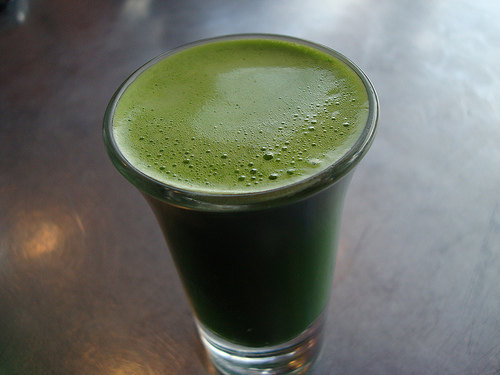

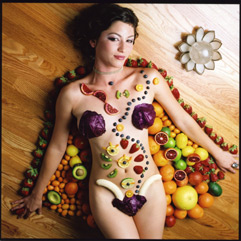
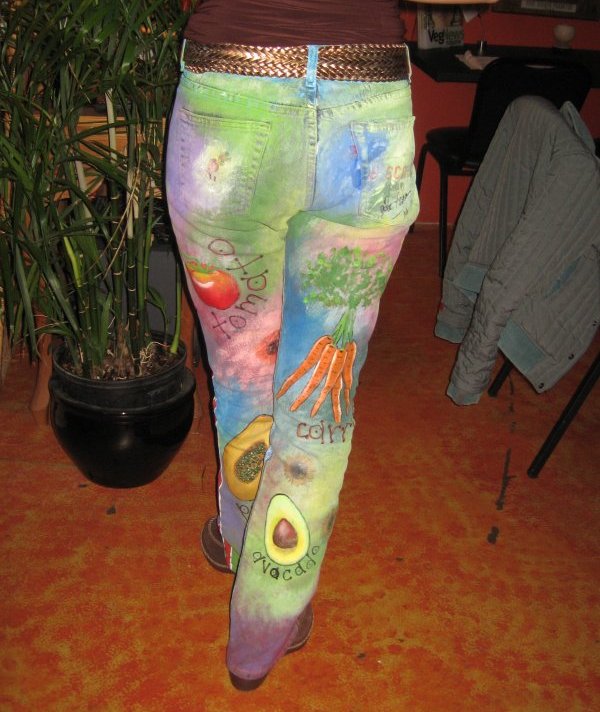




Wholesale to the Public
Your Wholesale Raw Foods & Equipment Connection
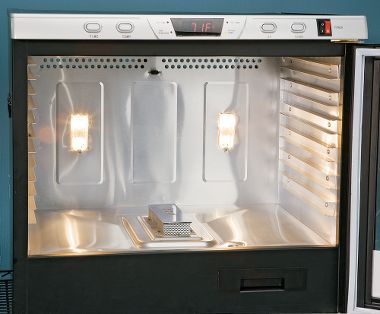
This is the best residential "commercial grade" dehydrator. Period. You won't need to rotate trays and still have even drying.
I love the digital thermometer. I don't like dials where I have to guess the temp. I love the glass too.
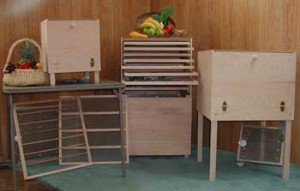
This is the wooden version of a dehydrator. These are the most expensive of all. It has no fan so it won't bring in dust.
These are the least oxidizing and the vent takes away moisture better than any dehydrator I've seen. This has accurate
heating elements so you know you aren't cooking your food too.
What makes a good dehydrator dehydrate dry foods quicker than another?
First thing that comes to mind is the structure of the drying system. A dehydrator can be more powerful, have higher tempurarures and bigger fans but unless it is designed correctly you will get un-even drying which has been a problem in the past until now.
With better air-flow systems the dehydrators can circulate the air better without blowing air chaotically causing un-even drying.
Helpful information for the dehydrator-wary
The most expensive dehydrator isn't necessarily the best!
You might be paying for shipping & import costs over long distances, or helping them recoup the costs of an otherwise inefficient production process.
Buy for your needs, or the amount of the food you will be using.
If you plan on getting a dehydrator just for yourself, don't try to run it all day and make foods for other people and wear out the motor.
Dehydrating is a very personal thing!
Say NO to cheap teflon sheets!
Paraflexx or high grade teflon sheets are worth the extra money. It has better reciprocal properties and outlasts all others. No danger of harboring fungus and not prone to leaching and is heat resistant; Paraflexx material is state of the art! Not sure what is the proprietary material; multi-layered is the standard: look for it.
Material Confusion. Get it...Got it...Great! Now don't make the same mistake we did.
Just like you wouldn't drink water out of polycarbonate water bottles that has been in the hot car all day...(yes, you will taste the plastic that was leached) you don't want to put your food on it either.
FANS....
Some models have smaller fans to support less food but are consequently under-drying and often deliver un-even drying when doing large amounts of food.. Remember your precious intestines! Blood! Bloating! Brain boggle! The whole purpose of us promoting dehydrators is for the raw living foods lifestyle.
Cheaply made corners. Avoid at all expense!!!!
This might gross you out but if you get a dehydrator that has 90 degree corners... it is all good at first but we have found that in all of our years of dehydrating, these sharp corners will make crevices where the corners meet. When this happens, food can get caught up in these cracks and accumulate mold and harbor bacteria. Once this happens, the bacteria start breeding on your food during the hours the mold spores blow on your food. If you have even made a D in elementary science class, you will know that mold spores proliferate in warm settings.
Metal Trays
Say NO!!!! to trays that are chrome plated... and especially don't use nickel plated plates. Food that is set on these at warm environments can cause the trays to rust which you do not want chipped away in your food. Only use stainless steel plates. Just like you wouldn't use cheap teflon pans... don't get chrome or nickel plated trays as a substitute for stainless steel. Unless you are in a commercial setting where trays are constantly being washed in commercial dish washers, high grade plastic trays are sufficient.
GOOD4U TIMER MODEL DEHYDRATOR - A FIRST LOOK!!
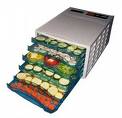
GOOD4U has taken an interesting approach to compete with their rivals. GOOD4U'S 10 tray timer model dehydrator has always been a top runner in the dehydrator game since its recent introduction. What they have done with the all new "greening of the dehydrator" blew us away!
While Good4U has always been a fierce competitor in every aspect including, power type, controled heat, casing type, and fan size. The fact that the lower powered fan in their 6 tray model left something to be desired.
The new and long anticipated 10 tray timer dehydrator will set a new standard in the industry. GOOD4U now has bragging rights as the machine with the GREENEST power supply in the industry. GOOD4U is green friendly, because their machine ranges from 500 watts to 600 watts of power, which rarely max out at this due to its design. You will notice less friction in the motor which creates less wear and tear creating lasting accurate tempuratures. Until now, most new dehydrators had stabilized tempuratures but as "some" dehydrators age one might notice that the tempurature where they set it at is not the same as what the thermostat claims. The greener motors allow for less power to be used with outstanding results. When it comes to fans, always go for back loading. When is comes to power, always go for the lesser power. They Good4U dehydrator has both.
FREE TEFLON SHEETS OR OTHER NON STICK SHEETS
This is a freebie that the dealer gives away. These are not usually the good 5 mil sheets that are expensive. If a dealer is giving away a free non-stick sheet for every tray you can bet it is not the sheets we approve of.
GLOSSARY OF TERMS:

Terms used regarding dehydrators.
Motor Life – This is the amount of use that you can expect to get from the motor in your dehydrator. Typically, the more powerful the motor, the longer the motor will last if it is not being used at its maximum wattage. We have found that smaller motors will burn out quicker if they are putting out the same work as the motors with bigger wattage running at mid capacity. Be careful with this, because it is going to vary based on time usage. The hotter the motor gets, the more friction is caused and this is why cool down time is a must. We laugh when we see companies mention an amount of life time for motors, because it is a variable measurement based on usage, not time.
Housing Material – The is the material that is used on the outer housing of the dehydrator. Many companies preach about their housing, weather that be ceramic, wood, metal, plastic, stainless steal, or now, there is a battle over who has the greenest dehydrator with the lightest and "greenest" dehydrator that uses the least amount of resources in its housing. But, but the real test comes from what the machines does. Does it dehydrate evenly or is its thermostat accurate? We like housing with high-grade plastic. Plastic from our research has the best performance in that it doesn't heat the housing such as the stainless steal models do which get hot and dissipate a lot of the heat. Most consumers do not want to pay for the high cost of stainless, but it is a great option for those that are not concerned about "green" dehydrators or power consumption.
Teflon sheets - We know this is the age old standard for cooking foods without worrying about it sticking. It is a good idea to have at least 5 mil sheets with the most amount of fibers in the sheets to avoid leaching. The more fibers, the more mil the sheets will be.
Polycarbonate – We are not sure what certain manufacturers of knock-off dehydrators were thinking when they put non food grade polycarbonate in their trays and housing but... do a search on google.com™ for “Polycarbonate Toxic�? and you will see what we mean. This link sums up why we think you should steer clear of anything with non food grade polycarbonate in it. If you want a cheap dehydrator and are doing non-food products then it is ok to get one of these.
Digital thermostats - With manual temperature control, you must adjust the temperature and always have the worry (on some dehydrators) that you might be getting temperatures that vary 5 to 10 degrees of what you set it at. Digital thermostats have eliminated the guess work out of heat control. We found that it is nearly impossible to get consistent temperature levels out of a machine with a manual flow control unless they have the type of high end thermostat that the Good4U models have. Digital thermostat control means that the computer adjusts the temperatures for you. Since this is done electronically, you never have to guess what temperature level water you are getting. Consistent temperature everytime. What a great idea!
Blow Rate – Blow rate refers to the speed at which the air blows from of the machine. Blow rates ranges from 5 MPH from the smaller 4 inch blades to 12 MPH from the 7 inch fans. Some companies make it a big selling point, but we found that the extra few MPH wind speeds it takes to evenly distributor the air among all trays is negligible concern unless all the trays are being used and the heat is cranked up (to us anyway). The heat must be turned on higher when the blow rate is higher due the loss of heat at the high wind speeds.
Flow Rate – This is where it gets tricky. High wind flow rate must blow in a systemized pattern, otherwise if the air is all blown to one corner then it will contribute to uneven drying such as when the corners of flax crackers get over dried while the middle of the cracker is still damp. You will not like when you make coconut macaroons and the macaroons on the top trays are hard as a rock and the middle macaroons are nice and still moist and eatable. NOTE: if the heat is too high and and the flow rate is not high it can cause over drying.
Power – This is a big deal! Why? Well, dehydrators like to make heat but they don't like to make heat in the process of making heat. If they get hot, they get angry. There are only two types of power sources available today. The first one is the age old transformer. It is a time tested power source, but it gets hot, and it does it fast. This means you can only use machines with transformers for a limited time before you need to give them a rest. The other method of power is called an SMPS. This is the wave of the future. More and more manufacturers are going this way, because it provides clean, cool power and it doesn’t get hot. This means no unnecessary wear the is the same power method used in high definition televisions, and no time limit on usage. Some commercial dehydrators use this technology but residential models do not require this. This is usually found in the 50 thousand dollar walk-in dehydrators where if the transformer got to hot, like it did in the old days, it would stop the dehydration process and all the food would spoil if not dehydrated all the way.
Tray Quantity – Most machines on the market have 9+ trays so that power consumption can be maximized. There are some machines with 4 and 5 trays as well, so what does it all mean? Of course, a machine with 9 trays is a huge step above a machine with 5 trays, but it goes further than that. 9 trays are proven (over and over again) to outperform 4 and 5 tray models by about 25%, but it doesn’t stop there. Once you decide on a dehydrator that has 9+ trays, be SURE to ask about tray size. The size of the trays are extremely important. Just because it has 9+ trays, doesn’t mean it is a good model. We want to see good surface area, and even 1 inch when measuring tray size can play a huge role. Ask how big the trays are in the machine of your choice. It’s very important and you deserve to know what you are buying..
Tray Size – Plate size is extremely important. The more surface area of the tray means that more food can be in contact with the air flow and if the trays are designed properly, heat can dehydrate the food evenly from the bottom. It is a simple scientific fact with no explanation needed, and no room for debate.
Tray Material – Almost all quality dehydrators use Polypropylene or stainless steel trays. The companies that coat their trays with nickel or chrome is not approved by us. It’s a good money saving short cut to make a heavy duty resembling model but we have learned that these compounds leach chemicals that are extremely toxic. Stick with Polypropylene plates if you are using it residentially or stainless steel if using it commercially.
Ease of Use - We set a rating system for ease of use. The system is the same one used in high school. F being the least user friendly and A+ being the most user friendly. Look for an A or an A+, you will be glad that you did. The dehydrators that are rated for food drying are rated differently than dehydrators for non-food purposes.
Temperature Adaptability – One of the things that boggles our mind is how a machine with a button that says 110 degrees is going to be able to maintain 110 degrees when food is constantly being heated and losing moisture. When many foods go into the dehydrator full of water it releases moisture and the heat is delivered into the foods. Many people have noticed with a Taylor thermometer that when they set the dehydrator at 110 degrees the temperature on the thermometer is 100 and they think their is something wrong with their dehydrator. The cause of this is the cooling of the dehydrator from the released moisture in the foods. But, when the food is finally dried, the thermometer gives the accurate reading that you set the dehydrator at. Good4U has a high-grade thermostat and it won't let the tempurature get too high once the moisture stops releasing. Many other companies have now addressed this challenge, but it seems like it can’t be long before all manufacturers have to follow suit. It is next to impossible to get accurate temperature settings without a high grade thermostat.
Warning about buying dehydrators with innacurate thermometers:
"Basically there is a controversy within the raw community (nothing new) about the degree of heat acceptable in dehydrating food. My stance is that we should let each person decide at what temperature they will dehydrate their food. If [names famous rawfood author, not Sprouttman] thinks that he can dehydrate bread at 140°F and not cook it - well that's OK with me. But if I feel that I don't want to dehydrate my bread at higher than 100 or 105 then why shouldn't I be able to do that?
If a machine says you turn the nob to here and it will be 95° and you turn the nob to here and it will be 100°, then it should reasonably be within that range. I can understand a 5 degree variation maybe, but no way should it be 15 to 35 degrees off. That is just false advertising and I think that many dehydrator manufactors know it and that is why they try so hard to convince people that the air temperature does not equal the temperature of the food.
There is some small degree of truth in this argument ... for example if you start a bread dehydrating at a higher temperature and because of the bulkiness of the bread (meaning it is not thin like crackers or wafers) it's true that the temperature of the bread mass will be lower than the air temperature at least on the inside of it. But at some point when the dehydration continues, and the moisture is reduced, you must be able to reduce the heat because if you don't reduce it when there is less moisture in it, then you will be cooking it. You should never dry food at too low a heat because it can spoil before it dries. It's like leaving food out on a hot day, it goes bad!
How Best to Store Dried Foods?
Moisture is the enemy of dried foods. When exposed to air, they absorb its moisture and become limp.
Brittle food is perfectly dried, while soft and pliable probably still has moisture. So leathery foods should be refrigerated to last for months, instead of weeks. Brittle will last for a year in your cupboard.
Always store dried foods in air-tight containers such as moisture-proof jars or zip-lock bags. Lids must contain rubber gaskets to make them moisture proof, e.g. Mason jars. Pop a cotton ball into the jar to absorb moisture.
The downside of glass jars is that light entering the jar can discolor some foods like tomatoes, and steal nutrients. Light isn't good for the essential fatty acids in dried seed and nut yogurts. Keep long-term storage jars in brown paper bags (foods you plan to eat in six months, not six weeks).
Store all containers in a dry, dark place with a moderate temperature. A cupboard, rather than an open pantry shelf, is best.
How Long to Dry the Food?
The lower the temperature inside the dehydrator, the longer the drying time.
Temperatures that are too low can cause food to spoil, which you may want, e.g. in making yogurt at 92°F. But after 8 hours, turn the temp up if like me you love yogurt crunch (yogurt dried into crackers). Cashew yogurt crunch cured me of my chocolate addiction - it's fat and sweet in the most healthy way!
The longer the food takes to dry, the more it's exposed to air and the more Vitamin C is lost. To speed up drying, you turn up the temperature. But the higher your drying temperature, the more food enzymes are lost. To retain all enzymes in the food, it's best not to go above 115°. Different food enzymes die off at different temperatures, but it's safe to say most are dying at 120°. If a food remains fairly wet after 24 hours, the chances for mold growth increase. It's like leaving food out on a hot day - it turns bad!
How To Slice or Blend?
The thicker the slice, or the wetter the cracker blend, the longer it takes to dry. Thicker slices come out leathery, thinner ones more brittle. Vegetables and fruits I slice thinner - 1/8 to 1/4 inch. I never dry them as quarters or halves. Sproutman writes that if you choose quarter or half, e.g. for tomato, then you must go to 125°-145°F.
With experience, you find for each favorite food a delicate balance between thickness, moistness, temperature, and drying time. Call our living foods coach if you would like help with dehydrating.
When touching foods for dryness, remember that they feel softer when they are warm. Always let it cool for a while - either turn off the dehydrator or remove the drying tray. If you are not sure if an item is sufficiently dry, it is better to overdry it than to underdry it. Fortunately, there is no such thing as an over-dried food. Once a food is dry, you do it no harm by leaving it in the dehydrator longer, unlike an oven that carries on baking and burning. So if zucchini or banana chips are meant to dry for 10 hours, and you come back home after 24, you still enjoy perfectly delicious chips!
Let's talk about Cheese!
I want everyone to know that cheese produced in the United States has legally allowed to have aluminum in it. ALL cheese made in the USA has Aluminum since its "allowed". It makes the cheese taste creamier. This is banned in Europe. Aluminum is responsible for many diseases and cancer. This is the main reason not to eat it... not just that it congeals your blood and clogs your arteries. If you are concerned either get your cheese imported from Europe or better yet...make your own raw vegan cheese in the dehydrator.
Raw Macadamia cheese can be made by blending in a 3 or 3+hp blender and then allowing it to ferment in a warm dehydrator. Our chefs on staff will help you with different cheese recipees if you need it. The cheese is protein rich and more digestable than cheese from milk. It actually tastes better.
Questions to know before buying a dehydrator:
1. Purpose:
I want a dehydrator to
Dehydrate living foods
Dehydrate meat for jerky
Buy it for other reasons.
2. Electricity
I want my dehydrator to
Use as little electricity as possible.
I don't care about the cost of electricity as long as it does the best job.
Please tell me more about the advantages and disadvantages of both types.
3. Timers
My dehydrator must have a
Built in timer.
No timer. I can save money by buying a timer at Radio Shack for under $10.
Why do I need a timer? I will call a raw food coach.
4. Thermostat
I dont need a thermostat
I need one that is very accurate, even though it may be more expensive.
The thermostat doesn't matter. I have a Taylor Thermometer and that's all the accuracy I need.
I will call one of your coaches who specializes in dehydrating and find out about all the models you carry.
5. Fans
I want a dehydrator that has a fan.
On the bottom, because I don't mind rotating trays if it means getting a cheaper dehydrator.
In the back, so the enzymes in the food on the bottom trays won't get cooked.
No Fan. I rather have a dehydrator that will not blow in outside dust and bacteria which can grow in the
warm climate inside the dehydrator.
6. Usage
I am dehydrating for
Just me.
Myself and my family and/ or friends.
Not sure yet.
7. Tray rotation
When using my dehydrator
I don't mind rotating trays if the final product is the same.
I absolutely do not have the time or patience to rotate trays every day.
8. Warranty
I want a warranty but
If it has a 1 year warranty-cool. I'll buy a new one when it breaks.
I'll pay more for one with a longer warranty.
I want one that that is made to last a long time.
9. Teflon sheet preferences
I need thin Teflon sheets. I don't plan on using them a lot.
I need the standard Teflon sheets that most stores sell with a dehydrator.
I want the best Teflon sheets on the market that won't "leech" the Teflon coating into my foods and that will last longer and are more durable.
DEHYDRATED FOODS ARE NOT RAW OR WHOLE
Most living things require water. Living water is found to be essential to the order found in plant and animal life forms.
Removal of water is a form of denaturing a living organism. In order to qualify as a 'whole food' all of the water drawn into the edible portion of the plant must be present.
We consist mostly of water. We draw our nutrients from a solution of water passing through our small intestine. When we eat food from which the water has been removed, we must replace that water by drinking beverages. This is never as good as the 'living' waters originally present in the whole food.
All forms of cooking, including dehydrating, are the remnants of ancient food preservation technologies. We have high speed refrigerated transportation technologies which sufficiently replace the need for the cooking technologies.
Dehydrated food is not only a type of fractionation, but also a form of cooking. It therefore does not meet the criterion for raw or even whole food.
More reasons NOT to buy a dehydrator.
The important alkaline mineral salts such as calcium are held in suspension in an ionic solution before they are able to be bound by the intestinal microflora. Dehydration and subsequent rehydration supplied by drinking additional water or the body fails to retain the ionic state of the various mineral nutrients present in the whole food. This makes the job of binding and transporting nutrients more difficult.
The idea that drinking water with meals is somehow unhealthy is an old myth. Consumption of dehydrated or otherwise cooked foods requires water be consumed to reconstitute these foods so they can be digested. The stomach has the ability to move digestive juices, enzymes and water in and out as needed to complete its digestive function. The waters in raw produce may be the valuable part. They contain most of the nutrients in solution ready to be digested and absorbed without drinking addtional water. Water used in a variety of vital functions such as circulation, digestion, excretion and absorption needs to be replaced. The best sources of our vital living waters are raw water foods such as fruit. This includes sweet, juicy and fatty fruit.
It is also beneficial to have an ample supply of pure alkaline water available as some supplemental water is desirable during warmer weather and periods of increased activity.
Drinking water is also beneficial when the diet consists of foods with lower water content such as nuts, seeds, fatty fruit and cooked food.
Warning about buying dehydrators with innacurate thermometers:
"Basically there is a controversy within the raw community (nothing new) about the degree of heat acceptable in dehydrating food. My stance is that we should let each person decide at what temperature they will dehydrate their food. If [names famous rawfood author, not Sprouttman] thinks that he can dehydrate bread at 140°F and not cook it - well that's OK with me. But if I feel that I don't want to dehydrate my bread at higher than 100 or 105 then why shouldn't I be able to do that?
If a machine says you turn the nob to here and it will be 95° and you turn the nob to here and it will be 100°, then it should reasonably be within that range. I can understand a 5 degree variation maybe, but no way should it be 15 to 35 degrees off. That is just false advertising and I think that many dehydrator manufactors know it and that is why they try so hard to convince people that the air temperature does not equal the temperature of the food.
There is some small degree of truth in this argument ... for example if you start a bread dehydrating at a higher temperature and because of the bulkiness of the bread (meaning it is not thin like crackers or wafers) it's true that the temperature of the bread mass will be lower than the air temperature at least on the inside of it. But at some point when the dehydration continues, and the moisture is reduced, you must be able to reduce the heat because if you don't reduce it when there is less moisture in it, then you will be cooking it. You should never dry food at too low a heat because it can spoil before it dries. It's like leaving food out on a hot day, it goes bad!
There are those that say.....
Do not buy a dehydrator unless it is made with furniture grade wood.
And, never make a dehydrator that has a fan inside. The last thing you will want is dirty air blowing all over your food. You wouldn't set your food out all day on the counter would you? These are closed systems with a vent for moisture to come out. These are the safest dehydrators to get if you plan on dehydrating. These Raw Foods Dehydrators do not require a fan for its efficient drying. The simple, effective design of this top-ventilated dryer creates a "chimney" effect: as air enters through the screened heater at the bottom, it warms and rises, taking moisture with it out the top. These are noiseless too.
A dehydrator is NOT necessary to transition to the symbiotic lifestyle. It is costly and will take time and energy and all you will do is denature the food.
Cooking is almost as bad. Cooking kills the nutrients and enzymes and the water. Dehyrators take out almost all the water which is the opposite of the way
a symbiotic lives. I hope after everyone reads this page they will not consider buying a dehydrator.
Those that are against dehydrators say.....
DEHYDRATED FOODS ARE NOT RAW OR WHOLE
Most living things require water. Living water is found to be essential to the order found in plant and animal life forms.
Removal of water is a form of denaturing a living organism. In order to qualify as a 'whole food' all of the water drawn into the edible portion of the plant must be present.
We consist mostly of water. We draw our nutrients from a solution of water passing through our small intestine. When we eat food from which the water has been removed, we must replace that water by drinking beverages. This is never as good as the 'living' waters originally present in the whole food.
All forms of cooking, including dehydrating, are the remnants of ancient food preservation technologies. We have high speed refrigerated transportation technologies which sufficiently replace the need for the cooking technologies.
Dehydrated food is not only a type of fractionation, but also a form of cooking. It therefore does not meet the criterion for raw or even whole food.
Drying fruits kills the oxygen reduction potential (see Demo page to learn about this). When constituted after soaking it in water, and after adding hydrogen boosters to the food, you can clearly see that the food has more energy than it started with. Dehydrated foods have tons of free radicals that can be eliminated from adding electrons to balance it. When reconstituted, the water you use does make a difference if you are concerned about the energy of the food. If you are concerned about oxidation you might want to research why you want to dip your foods into water that has the hydrogen boosters added to it. We never recommend dipping food into water that has a preservative solution in it such as those that many dehydrator stores sell.
More reasons NOT to buy a dehydrator.
The important alkaline mineral salts such as calcium are held in suspension in an ionic solution before they are able to be bound by the intestinal microflora. Dehydration and subsequent rehydration supplied by drinking additional water or the body fails to retain the ionic state of the various mineral nutrients present in the whole food. This makes the job of binding and transporting nutrients more difficult.
As a symbiotic rawfoodist you will never hear me recommending a dehdyrator to anyone. None of my friends who eat predominately living foods own a dehydrator. It takes up a lot of electricity and time and you lose nutrition. If you are just transitioning off the S.A.D. diet it could be a transition but it is not necessary. Don't fool your body into thinking it is getting cooked food. For those that I have sold dehyrators to in the past are now returning them to me. I wish I knew who first introduced dehyrators to those starting the living foods diet. It is not a substitute. Don't fall for it.
The electricity a dehydrator uses is very expensive, requiring usually 12 to 24 hours of continuous operation unless you get one of the wooden ones.
There are a few reasons we use it but not to just eat dehydrated food for the sake of eating to appeal to our food addictions.
Today we have modern refrigeration. There is rarely a need for dehydrated foods unless you are going to be in extreme situations or you are going on a trip where you will have a hard time finding nutritious food.
NOTE TO THOSE TRANSITIONING TO THE RAW LIFESTYLE:
You might not want to buy a dehdyrator after reading this.
As you might have read on our site, dehydrating by using air and heat can lower the ORP and Brixxe level of the food, the food oxidizes and can lose most of its nutrition when sitting in a dehydrator for 12 hours that it takes to dehdyrate most foods, plus the electricity costs. For most of those that have read our website, they may want to eat dehydrated foods to transition off of cooked foods. Most usually will keep their dehydrator for about 6 months and then they won't need it anymore.
We use a different machine to make our food. It is not done by heat and air in a dehydrator that can cause mold and oxidize the nutrients.
The new process is called Water-Lyfolization. It uses pressure at 33 degrees that extracts moisture as it crystilizes the water as it evaporates in this pressurized chamber. This does not destroy the ORP and nutrition like a dehydrator can do.
During this process, product volume changes must be prevented at all costs. If dried from the liquid instead of the frozen state, one can end up with a shrunken and insoluble product. As the water leaves the liquid food, the surface tension increases, and the food can collapse under this tension. If this happens, the food becomes grossly shrunken and no porous, interstitial openings are left in the food for rehydration. As a result, the product is useless.
Although this process has been a useful process for as much as fifty years now, its consumer applications can be limited by high capital cost for the drying unit and high operating costs for the vacuum and condenser. This does not rupture the membranes of the food since it is done at 33 degrees, below the freezing point. This does not form ice crystals like foods that frozen foods that can have it's cell membranes destroyed. This is another reason we avoid frozen foods. This process can prevent rupture of the cell membranes by giving time to diffuse water out of the cell or to alter the shape of the membrane. This process doesn't take hours like a dehdyrator and almost all the nutrients are left intact and the ORP level is hardly altered. The worst thing that can happen when dehydrating foods is to destroy the nutients and zap its food energy. Take an ORP meter and you can test the electrical charge of the food from a air and heat dehydrator and the food from the process we use.
Food is heat sensitive so doesn't it make sense not to expose it to heat and air? Isn't the whole idea of eating better to get more nutrients?
The place that makes food using this process also makes Farinas. Faranas are a ground combination of handcrafted, nutrient-dense whole foods that you can throw in the blender with your smoothie.
If you would like to know more about foods using this process or watch the Whole Truth 22 minute DVD, call 1-727-612-2345. Ask for Tom. Mention that you have read this page. Samples are available for a small shipping charge.
With this in mind..... let us tell you the types of dehydrators that are available, or ones that you can build yourself.